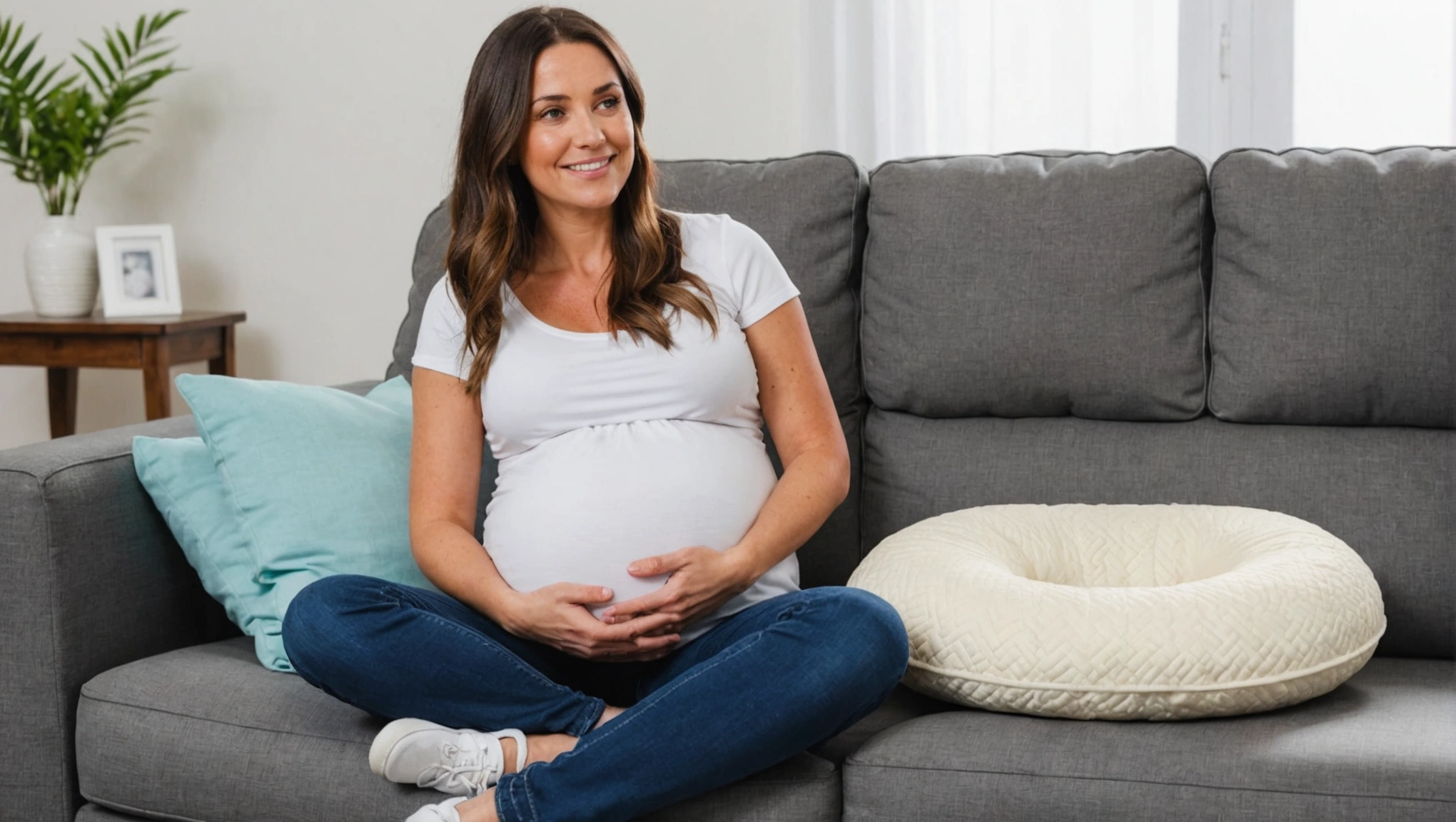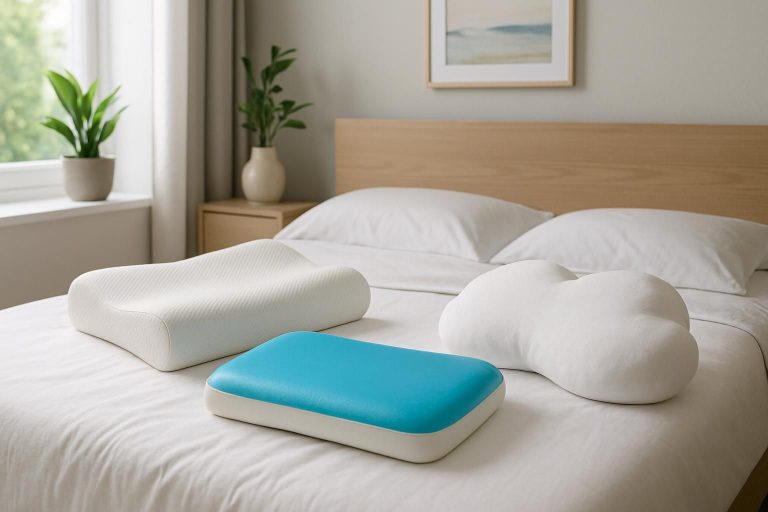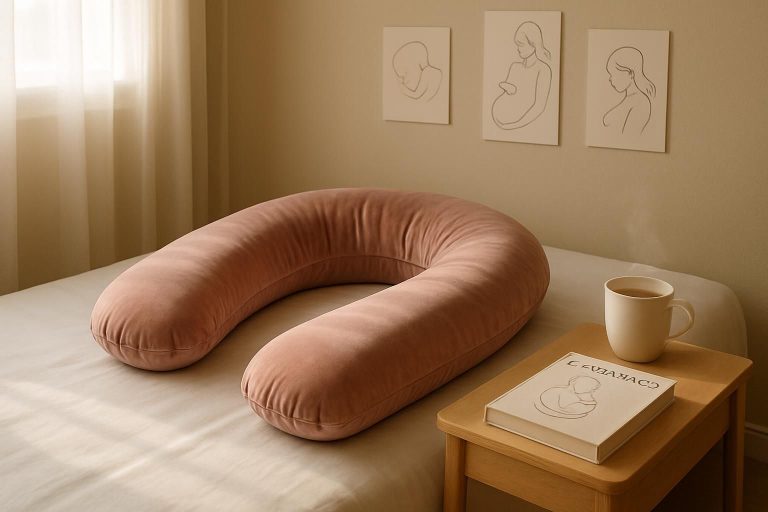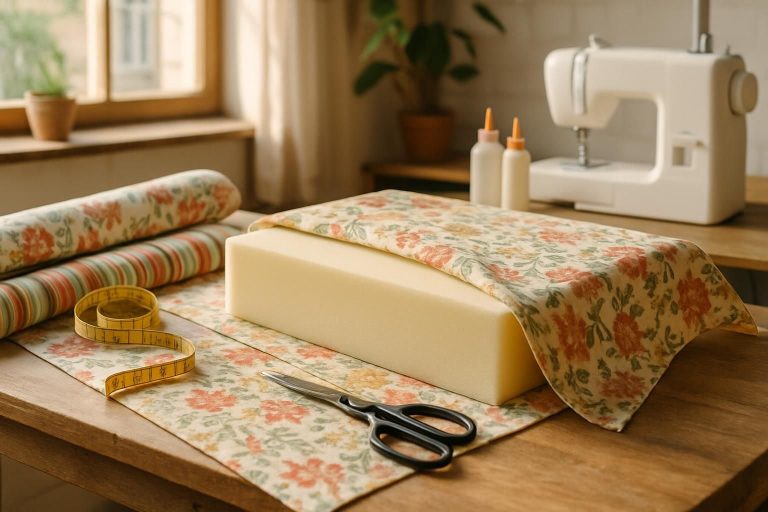Choosing a pregnancy pillow is an important step to support pregnant women in their daily lives. Throughout maternity, this type of pillow offers much more than a simple accessory: it provides tailored support for specific tensions associated with pregnancy, while significantly enhancing overall comfort. Expectant mothers often find it challenging to find a suitable position for good sleep and to reduce back or hip pain. A quality pregnancy pillow is a valuable ergonomic solution, helping to better distribute loads and create a supportive cocoon. Moreover, its use is not limited to the prenatal period. It also supports the first postpartum weeks, especially during breastfeeding, promoting a natural and comfortable position for both mom and baby. Each pillow differs in shape, size, filling, and dimensions, making it essential to understand their utility and specific features to make an informed choice. Discover a comprehensive guide to help you confidently navigate this purchase, with a special focus on quality, versatility, and the essential comfort needed during maternity.
The U-shaped pregnancy pillow is recognized for its wide coverage and cocooning enveloping effect. It surrounds the expectant mother, providing a full support from the back to the belly, and even the legs. This type of pillow is particularly recommended for pregnant women seeking absolute comfort and optimal support in all positions.
The U-shape also allows it to adapt perfectly to changing needs throughout the night, offering excellent support regardless of movement.
Who is the U-shaped pregnancy pillow for?
This pillow is ideal for:
-
Pregnant women experiencing significant back or hip pain
-
Those needing maximum support to sleep comfortably
-
Women who prefer a large enveloping support surface
-
Expectant mothers with a broader or more robust physique
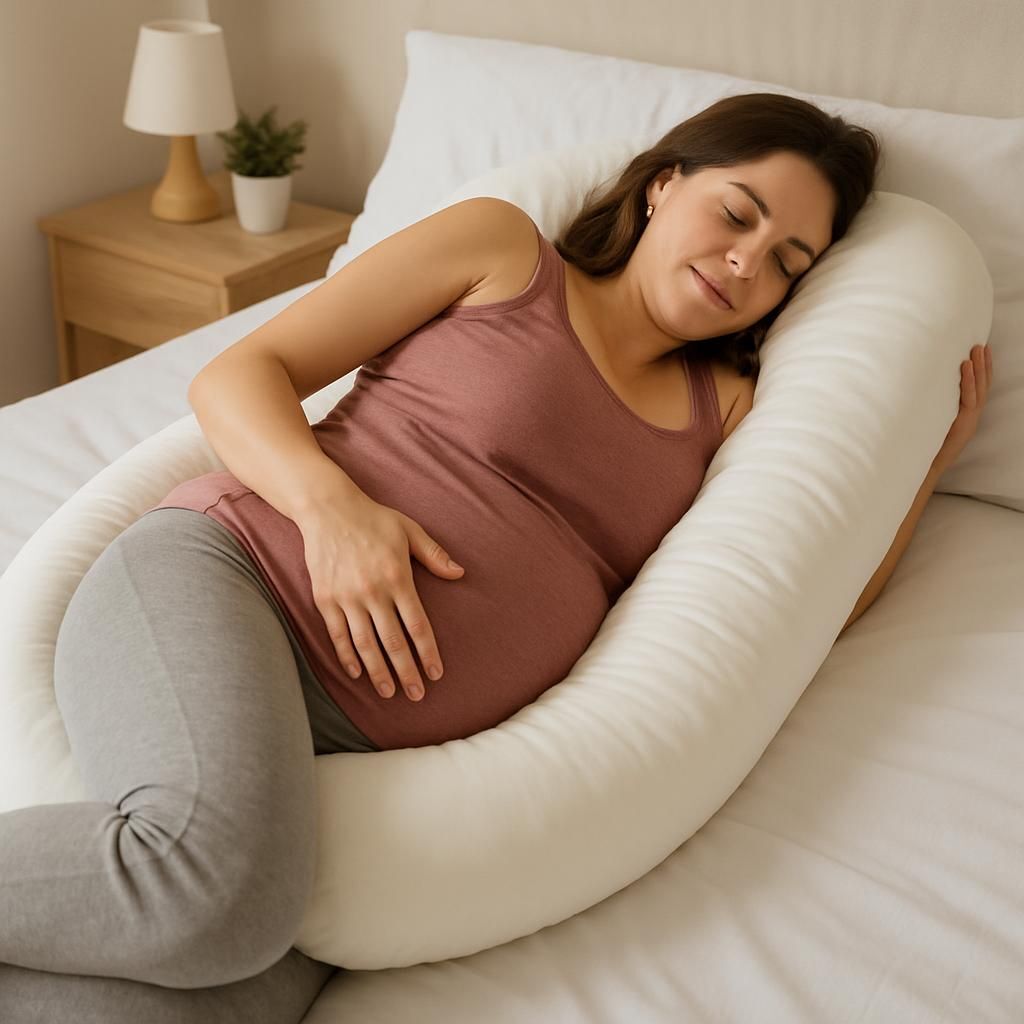
Thanks to its substantial structure, it is advisable to have a sufficiently large bed to avoid excessive bulkiness.
The C-shaped pregnancy pillow: targeted support in a compact design
The C-shaped pillow combines good support with a certain level of compactness. Its shape, less bulky than a U-shape pillow, allows easy use in limited spaces, while providing effective support for the belly and back. It is suitable for women with traditional sleeping habits who desire targeted assistance, especially in the lumbar and abdominal areas.
This type of pillow is very popular among those looking for a compromise between comfort and practicality, without taking up too much space in the bed.
The J-shaped pregnancy pillow: versatility and adaptability to every need
The J-shaped pregnancy pillow is a versatile choice, combining several advantages. It offers pronounced back support while maintaining comfortable support around the belly. Thanks to its asymmetrical shape, it easily adapts to the occasional needs of pregnant women, whether for sleeping, settling in or resting the legs.
This shape is also ideal for mothers who like to change positions frequently during the night.
The straight or banana-shaped pillow: modularity and practicality
The straight pillow, sometimes called banana-shaped, offers interesting modularity. It can be positioned in different ways according to preferences, such as under the belly, between the legs, or in the back. Its compact size makes it a must-have for smaller beds and for women seeking a multifunctional accessory.
Adjusting the pillow to your body and sleeping habits
The choice of shape should also take into account the expectant mother’s habits:
-
If she prefers sleeping on her side, a U- or J-shaped pillow offers enveloping support
-
For those who move little, a C or straight pillow may suffice
-
Taller women will benefit from longer pillows capable of following the body’s entire curve
-
Shorter expectant mothers can opt for compact yet ergonomic models
|
Pillow Type 📏 |
Key Features |
Advantages ⭐ |
Recommended Profile |
|---|---|---|---|
|
U-shaped |
Enveloping shape, full body support |
Complete support, very comfortable |
People with significant pain, broad body types |
|
C-shaped |
Compact shape, targeted support |
Space-efficient, effective |
Expectant mothers with limited space, stable sleep |
|
J-shaped |
Asymmetrical, versatile |
Adaptable, reinforced back support |
Women who frequently change positions at night |
|
Straight/Banana |
Modular, flexible |
Practical, lightweight |
Small beds, women seeking a multifunction pillow |
How to choose the ideal size for your pregnancy pillow? 📏⭐
Recommendations based on the mother’s height and build
A good level of comfort also depends on choosing an appropriate size. It is essential that the pillow effectively supports the silhouette and accommodates nocturnal movements without being too restrictive. For taller women, a long pillow (over 140 cm) is recommended to cover the entire body, while shorter builds should opt for smaller, more compact models to maintain freedom in bed.
Body type also plays a role: wider pillows are better suited for curvier women, offering a generous support surface, while slimmer figures can choose less bulky fillings that still provide sufficient support.
To help with your choice, here are some easy guidelines to remember:
-
Small stature (less than 1.60 m): pillow between 110 and 130 cm
-
Medium height (1.60 m to 1.75 m): pillow 130 to 150 cm
-
Great size (over 1.75 m): cushion 150 cm or more
Finding the right balance between comfort and bed space
Another factor to consider is the sleeping area. A cushion that is too large can quickly become inconvenient by reducing the available space, which affects the quality of sleep for both partners. It is therefore recommended to measure your bed and assess the space allocated to the cushion, especially for U-shaped models that take up a lot of room.
Labels and user reviews, particularly those from PharMeDoc or Niimo, emphasize the importance of properly positioning the cushion according to its placement in the bed, without sacrificing the comfort that pregnant women deserve.
-
Measure the width and length of your bed 🛏️
-
Allow at least 30-40 cm of free space around the cushion
-
Prioritize compact models if your bed is narrow
-
Test in store if possible or read user reviews
|
Mother’s profile 🛏️ |
Recommended cushion length 📏 |
Space considerations |
|---|---|---|
|
Small stature |
110-130 cm |
Favor compact models to avoid overcrowding |
|
Medium height |
130-150 cm |
Balance between comfort and space |
|
Tall |
150 cm and more |
Large bed recommended to optimise usage |
Which filling to choose for a healthy and comfortable pregnancy cushion? 🌱⭐
Microbeads: lightness and malleability suited for sleep
Microbead-filled cushions are ideal for expectant mothers looking for a lightweight and highly malleable cushion. The small beads allow the cushion to perfectly conform to the shape of the body and adapt to positions during the night without becoming rigid. This greatly improves comfort, especially for those who change positions frequently.
The brand Pharmedoc offers models with this type of filling, known for its breathability and the coolness it provides during sleep.
Memory foam: firm support and adaptation to body shape
Cushions with memory foam provide firm support and a very appreciated enveloping effect. This material reacts to body heat, molding to the silhouette for personalized support. It is ideal for those who want solid support for the back, belly, or legs, ensuring lasting comfort.
On the other hand, this foam is heavier and less breathable than microbeads, which may not suit all expectant mothers. Brands like Tinéo or Lannvan offer this type of cushion for specific uses where support is prioritized.
Polyester fibers or natural materials: benefits and cautions ⚠️
Polyester fibers are common due to their affordability and light weight. They provide a soft, pleasant feel but can lose volume over time. Some natural fibers, like wool or cotton, offer excellent breathability and a more natural sensation, while also having a lower ecological impact. However, they tend to be heavier and require more careful maintenance.
It is essential to pay attention to the exact composition of the filling, avoiding materials that could cause allergies or irritations.
Choosing a hypoallergenic and certified filling for safety
Regardless of the filling type, it is strongly recommended to opt for a pregnancy cushion with hypoallergenic filling and health certifications. This ensures the absence of harmful substances and reduces allergy risks, which is crucial during pregnancy.
Brands like PharMeDoc and Niimo emphasize the quality of their fillings, often compliant with OEKO-TEX standards or other safety labels guaranteeing a healthy product.
-
Microbeads: lightness, adaptability, freshness
-
Memory foam: firm support, personalized comfort
-
Polyester fibers: softness and affordable price
-
Natural materials: eco-friendly, breathable, but heavier
-
Choose certified hypoallergenic fillings
|
Filling type 🌱 |
Advantages ⭐ |
Points to watch ⚠️ |
Examples of brands |
|---|---|---|---|
|
Microbeads |
Lightweight, malleable, suitable for movement |
Can lose air over time |
Pharmedoc, Niimo |
|
Memory foam |
Firm, ergonomic support |
Heavier, less breathable |
Tinéo, Lannvan |
|
Polyester fibers |
Soft, affordable |
Durability may be limited |
Queen Rose |
|
Natural materials |
Breathable, eco-friendly |
Weight, more demanding maintenance |
Niimo |
The importance of the cover: comfort, hygiene, and practicality in daily life 🧺🌱
Choosing the fabric: cotton, breathable materials, and hypoallergenic properties
The pregnancy pillow cover plays a key role not only in comfort but also in hygiene and the longevity of the product. Natural fabrics, such as organic cotton, are highly recommended for their softness, breathability, and hypoallergenic properties. These fabrics help regulate temperature overnight, preventing sweat and irritation.
The use of breathable technical materials also ensures better moisture wicking, significantly enhancing comfort. PharMeDoc and Niimo incorporate many of these aspects into their designs, which are highly appreciated by expectant mothers concerned about their well-being.
Removable and washable covers: for long-term use
A cushion with a removable and machine-washable cover is a significant advantage. It ensures perfect hygiene, essential for avoiding allergen or dust buildup, especially during maternity when skin is often more sensitive.
Several brands such as PharMeDoc or Queen Rose offer washable covers at 30°C or 40°C, making regular cleaning easier and helping to extend the cushion’s lifespan. It’s also useful to have additional covers to alternate daily.
-
Prioritize organic cotton and natural fabrics 🧺
-
Choose a breathable and skin-friendly cover
-
Ensure the cover is removable and machine washable
-
Have spare covers on hand
|
Criterion 🧺 |
Recommendation |
Impact on comfort and hygiene |
|---|---|---|
|
Fabric |
Organic cotton or breathable materials |
Softness, hypoallergenic, thermal regulation |
|
Removable cover |
Yes, with zipper |
Ease of maintenance, better hygiene |
|
Machine washable |
Recommended at 30°C or 40°C |
Cleanliness, cushion durability |
|
Spare cover |
Optional but useful |
Convenience and simplified maintenance |
Tips for choosing and using your pregnancy pillow effectively 💡🤱
Essential criteria: comfort, shape, maintenance, eco-friendliness, and versatility
Choosing a pregnancy pillow isn’t just about its shape or size. Several factors should be considered to ensure a wise purchase:
-
Comfort: choose filling suited to your preferences and any pain points
-
Shape: select based on your body type and sleeping habits
-
Maintenance: prefer cushions with removable and washable covers
-
Eco-friendliness: prioritize natural or certified materials, responsible brands
-
Versatility: the cushion should support maternity needs, including breastfeeding
This set of criteria ensures a durable cushion that will seamlessly fit into daily life, with a real positive impact on the comfort of the mother.
Prioritize quality cushions and reviews from other users ⭐
Reading reviews from other users provides valuable insight. Feedback on models from PharMeDoc, Niimo, or Queen Rose helps understand how the cushion holds up over time, the quality of support, and actual comfort.
It is also recommended to choose reputable brands tested in maternity settings to minimize the risk of disappointment and to ensure the best experience possible.
Practical tips for using during pregnancy and breastfeeding
-
Place the cushion under the belly and between the legs to optimize lateral positioning 🛏️
-
Use the cushion to support your back if you remain seated for long periods
-
After childbirth, use it as a breastfeeding support to relieve arms and back 🤱
-
Comfortably rest the baby on the cushion during relaxation times
Value for money: investing in a durable cushion for your well-being
A quality pregnancy cushion is a real investment in comfort and health, especially by promoting restorative sleep. Rather than opting for a low price, it is better to choose a durable and ergonomic product that will also be useful during breastfeeding and the initial rest periods of the baby.
Des brands like PharMeDoc, Niimo, or Lannvan offer an excellent balance between quality and price, with solid warranties.
|
Criteria 💡 |
Tips to Remember |
Impact on Use and Comfort |
|---|---|---|
|
Comfort and Shape |
Select based on pain and sleeping habits |
Significant improvement in sleep and relaxation |
|
Maintenance (removable cover) |
Opt for a removable and washable cover |
Maintains hygiene, extends lifespan |
|
Eco-friendliness |
Favor natural materials and certifications |
Reduces environmental impact |
|
Versatility |
Choose a cushion usable during breastfeeding |
Better long-term investment |
FAQ
From which month is it recommended to use a maternity cushion?
The cushion can be used from the second trimester to anticipate the growing belly and improve sleep comfort. It is particularly beneficial from the sixth month when the belly becomes larger.
Can a maternity cushion be used for breastfeeding?
Yes, most maternity cushions are designed for postnatal use. They facilitate breastfeeding by supporting the baby at the right height, while relieving the mother’s arms and back.
How to best care for your maternity cushion?
Prefer a removable and washable cover that can be machine washed. It’s recommended to wash the cover regularly at 30°C or 40°C, according to the manufacturer’s instructions, and to air out the cushion to prevent moisture buildup.
Is a maternity cushion suitable for all body types?
Yes, provided you choose the shape and size that fit your silhouette. U-shaped cushions are often better suited for broader body types, while C or straight models are ideal for more petite profiles.
Are there eco-friendly maternity cushions?
Yes, several brands offer cushions made from natural materials, certified organic and hypoallergenic, such as Niimo, which emphasizes environmental responsibility while ensuring maximum comfort.
